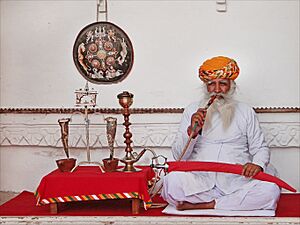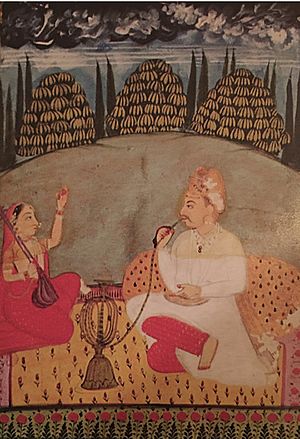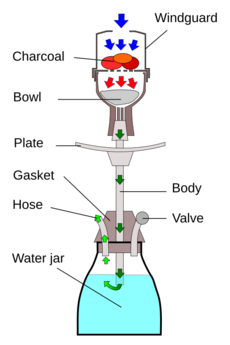Hookah facts for kids
A hookah (also called shisha or waterpipe) is a special tool used for smoking. It has one or more stems. People use it to heat or vaporize tobacco, often flavored tobacco called muʽassel. The smoke then goes through a water container, usually made of glass, before someone breathes it in.
It's important to know that smoking tobacco with a hookah can be harmful to your health. It exposes people to chemicals and other things that are not good for the body. Sharing hookahs can also spread germs. Because of these concerns, hookah use is a public health issue around the world. It is common in the Middle East, North Africa, and among young people in places like the United States and Europe.
The hookah was likely invented by Abul-Fath Gilani, a Persian doctor who worked for Emperor Akbar in India. This happened in the city of Fatehpur Sikri during the Mughal Empire. From India, the hookah spread to Persia, where its design was changed. Then it moved to the Near East. Some people think it might have started in Persia first, then spread to India.
Even though tobacco was seen as something to avoid when the hookah was first made, it became very popular. First, it was used by important people, and then it became widely accepted. Today, people often vaporize flavored tobacco instead of burning it. But in some rural parts of South Asia, the original hookah is still used. They smoke a pure tobacco called tumbak by burning it directly with charcoal. This method delivers more tobacco and nicotine, which can cause more health problems.
The word "hookah" comes from "huqqa," a word from the Hindustani language. This word originally came from Arabic. Outside of its home region, hookah smoking has become popular worldwide, especially among younger people.
Contents
History of the Hookah
In the Indian city of Fatehpur Sikri, Christian missionaries from southern India brought tobacco to the Mughal emperor Akbar the Great (who lived from 1542 to 1605 AD). Louis Rousselet wrote that Akbar's doctor, Hakim Aboul Futteh Ghilani, then invented the hookah in India.
However, an old poem by a Persian poet named Ahlī Shirazi (who died in 1535) talks about using a ḡalyān (another name for hookah). This suggests that hookahs were used even earlier, during the time of Shah Ṭahmāsp I. So, it seems that Abu’l-Fath Gilani might have introduced the ḡalyān, which was already used in Persia, to India. But there is no clear proof of the water pipe existing before the 1560s. Also, tobacco probably arrived in India in the 1600s. Before that, people might have smoked something else in the ḡalyān.
After Europeans brought tobacco to Persia and India, Hakim Abu’l-Fath Gilani, who was from a province in northern Persia, moved to Hamarastan. He later became a doctor in the Mughal court. He became worried about health when smoking tobacco became popular among Indian noblemen. He then thought of a way to pass smoke through water to "clean" it. Gilani introduced the ḡalyān after an ambassador encouraged Emperor Akbar I to try smoking. Because it became popular among noblemen, this new smoking device quickly became a sign of importance for rich and powerful people in India.
Modern Hookah Design
Today, hookah makers are using better materials. Instead of copper, brass, or cheap metals, they use stainless steel and aluminium. For the hoses, they now use silicone rubber instead of leather and wire. These new materials make modern hookahs stronger. They also don't hold smells from smoking and can be washed without rusting or growing bacteria. New ideas and designs are changing how hookahs look. Even with these improvements, many hookahs are still made with older methods. This is because modern equipment is expensive and not always available where hookahs are traditionally made.
How a Hookah Works
The glass jar at the bottom of the hookah is filled with water. The main tube of the hookah goes into the water by a few centimeters. This tube is sealed tightly to the jar. Filling the water deeper would just make it harder to breathe in. Tobacco or tobacco-free molasses is placed in the bowl at the top of the hookah. Often, the bowl is covered with a piece of tin foil with holes or a metal screen. Hot charcoal is placed on top of this. The foil or screen keeps the charcoal and tobacco separate. The tobacco gets hot, but not hot enough to burn like a cigarette.
When someone breathes in through the hose, it creates a vacuum in the water jar. This pulls the smoke down the tube and through the water, making bubbles. At the same time, air is pulled over the hot coals and gets heated. This hot air then goes through the tobacco mixture. The heat from the coals and hot air makes the vapor. This vapor goes down the main tube into the water. It bubbles up through the water, cools down, and fills the top part of the jar where the hose is attached. When a user inhales from the hose, the smoke goes into their lungs. This change in pressure pulls more air through the charcoal, and the process continues.
If there is a lot of vapor in the bowl above the water, it can be let out through a special valve. This valve opens when someone gently blows into the hose.
Health Information
Smoking tobacco with a hookah can have serious health effects. The water in a hookah does not filter out many of the harmful chemicals found in tobacco smoke. These chemicals come from the burning charcoal, the tobacco, and the flavorings. They can cause problems for your body.
When people share a hookah, there is a risk of spreading germs. This can include germs that cause infections like oral herpes or the flu. Using your own mouthpiece might help, but it doesn't remove all the risk.
Smoking tobacco with a hookah can affect your body right away. It can make your heart beat faster and raise your blood pressure. Some people might feel sick, get a headache, or feel very tired. This is sometimes called "hookah sickness."
Over time, smoking tobacco with a hookah can lead to long-term health problems. It can affect your lungs, heart, and even your teeth and gums. It's important to understand that using a hookah with tobacco is not good for your health.
Even people who are around hookah smoke can be affected. Secondhand smoke from hookahs contains many harmful substances. Studies have shown that the air in places where hookahs are smoked can have unhealthy levels of these chemicals. Being around this smoke can cause breathing problems like coughing or wheezing.
Images for kids
See also
- Bong
- Electronic hookah
- Incense
- Pipe smoking








